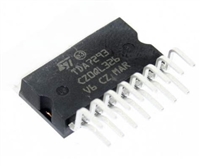Typical Performance Characteristics: continued
Demodulator Voltage vs. Distance for Different RF
Object
Detected
(T = 21°C, V
CC
= 12V)
1.75
1.5
2.5kW
5kW 7.5kW
12.5kW
15kW
17.5kW
Object Not
Detected,
1.25
L Unloaded.
1.0
0.75
0.0
0.100
0.200
Distance To Object (in.)
0.300
0.400
Principle of Operation
The CS209A is a metal detector circuit which operates on
the principle of detecting a reduction in Q of an inductor
when it is brought into close proximity of metal. The
CS209A contains an oscillator set up by an external parallel
resonant tank and a feedback resistor connected between
OSC and RF. (See Test and Applications Diagram) The
impedance of a parallel resonant tank is highest when the
frequency of the source driving it is equal to the tankÕs res-
onant frequency. In the CS209A the internal oscillator
operates close to the resonant frequency of the tank circuit
selected. As a metal object is brought close to the inductor,
the amplitude of the voltage across the tank gradually
begins to drop. When the envelope of the oscillation reach-
es a certain level, the IC causes the output stages to switch
states.
is well outside the trip point. Higher values of feedback
resistance for the same inductor Q will therefore eventu-
ally result in a latched-ON condition because the residual
voltage will be higher than the comparatorÕs thresholds.
As an example of how to set the detection range, place the
metal object at the maximum distance from the inductor
the circuit is required to detect, assuming of course the Q
of the tank is high enough to allow the object to be within
the ICÕs detection range. Then adjust the potentiometer to
obtain a lower resistance while observing one of the
CS209A outputs return to its normal state (see Test and
Applications Diagram). Readjust the potentiometer slow-
ly toward a higher resistance until the outputs have
switched to their tripped condition. Remove the metal
and confirm that the outputs switch back to their normal
state. Typically the maximum distance range the circuit is
capable of detecting is around 0.3 inch. The higher the Q,
the higher the detection distance.
The detection is performed as follows: A capacitor con-
nected to DEMOD is charged via an internal 30µA current
source. This current, however, is diverted away from the
capacitor in proportion to the negative bias generated by
the tank at TANK. Charge is therefore removed from the
capacitor tied to DEMOD on every negative half cycle of
the resonant voltage. (See Figure 1) The voltage on the
capacitor at DEMOD, a DC voltage with ripple, is then
directly compared to an internal 1.44V reference. When the
internal comparator trips it turns on a transistor which
places a 23.6k½ resistor in parallel to the 4.8k½. The result-
ing reference then becomes approximately 1.2V. This hys-
teresis is necessary for preventing false triggering.
For this application it is recommended to use a core
which concentrates the magnetic field in only one direc-
tion. This is accomplished very well with a pot core half.
The next step is to select a core material with low loss fac-
tor (inverse of Q). The loss factor can be represented by a
resistance in series with the inductor which arises from
core losses and is a function of frequency.
The final step in obtaining a high Q inductor is the selec-
tion of wire size. The higher the frequency the faster the
decrease in current density towards the center of the wire.
Thus most of the current flow is concentrated on the sur-
face of the wire resulting in a high AC resistance. LITZ
wire is recommended for this application. Considering
the many factors involved, it is also recommended to
operate at a resonant frequency between 200 and 700kHz.
The formula commonly used to determine the Q for par-
allel resonant circuits is:
The feedback potentiometer connected between OSC and
RF is adjusted to achieve a certain detection distance
range. The larger the resistance the greater the trip-point
distance (See graph Demodulator Voltage vs Distance for
Different RF). Note that this is a plot representative of one
particular set-up since detection distance is dependent on
the Q of the tank. Note also from the graph that the capaci-
tor voltage corresponding to the greatest detection dis-
tance has a higher residual voltage when the metal object
R
2¹fRL
QP
@
3






 ?TPA3116D2功放芯片参数详解、引脚说明
?TPA3116D2功放芯片参数详解、引脚说明

 74HC165引脚说明、驱动程序示例解读
74HC165引脚说明、驱动程序示例解读

 深入解析AD9833:DDS频率合成器的卓越性能与广泛应用
深入解析AD9833:DDS频率合成器的卓越性能与广泛应用

 高性能TDA7293音频功率放大器技术特性与应用分析
高性能TDA7293音频功率放大器技术特性与应用分析
